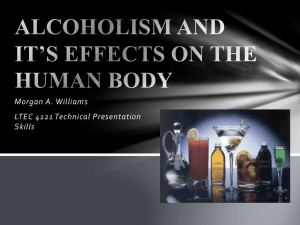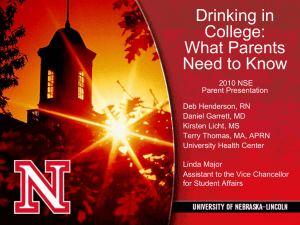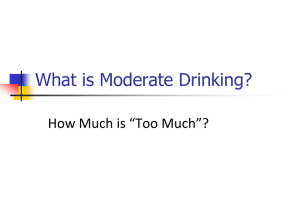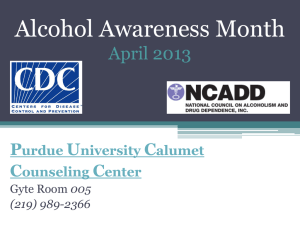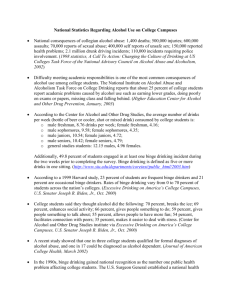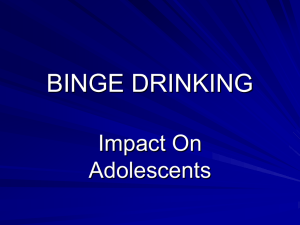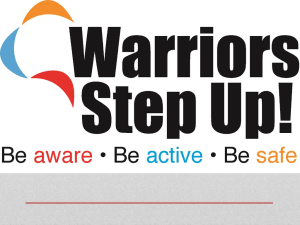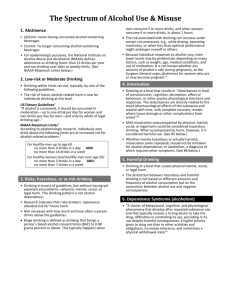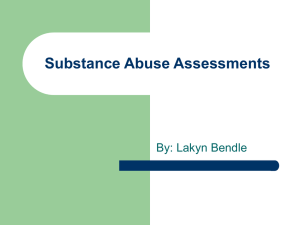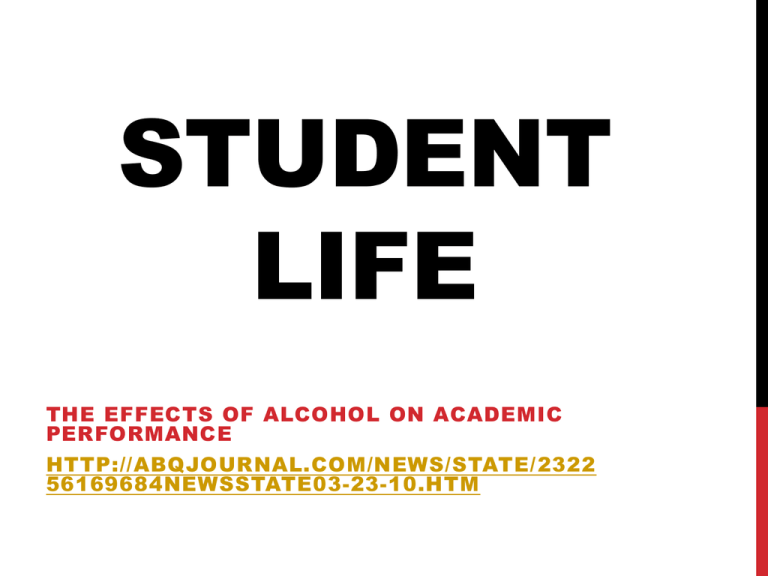
STUDENT
LIFE
THE EFFECTS OF ALCOHOL ON ACADEMIC
PERFORMANCE
HTTP://ABQJOURNAL.COM/NEWS/STATE/2322
56169684NEWSSTATE03-23-10.HTM
http://www.youtube.com/watch?v=g2gVzVIBc_g
http://www.youtube.com/watch?v=zXjANz9r5F0
2.15
PERCEPTION
TARGETS
College Students are one of the largest targeted groups by
alcohol advertisers.
WHY COLLEGE
STUDENTS?
Some researchers have concluded that the cultural myths
and symbols used in alcohol advertisements have powerful
meanings for college students and affect intentions to drink.
POPULARITY
ALCOHOL REMAINS popular with American college students,
as indicated by the Core Institute Survey. In 2007, 84.2% of
college students reported drinking alcohol, an increase of 2%
over the prior year. Moderate to heavy drinking also
increased with corresponding reductions in abstention and
light drinking. Nationwide, students reported consuming an
average of 5.64 drinks per week in 2007, up about 7% over
the prior year.
MASS CONSUMPTION
The Core Institute also reported that 45.5% of students had
consumed five or more drinks in one sitting in the previous 2
weeks. More than 21% of the students reported three or more
episodes of this kind of high-risk drinking in the previous 2
weeks. Finally, more than 90% of American college students
reported that drinking is a central part of campus social life.
HOW STUDENTS
CONSUME
PARENTAL MONITORING & ALCOHOL USE
AMONG STUDENTS
• Protective factor and useful strategy to prevent substance
misuse among students
• In 2008, of 34,840 students accepted to the affiliated high
schools, 28,996 students (51.8% female) completed the
alcohol survey and of 37,683 students accepted into
university 30,084 students (51.5% female) completed the
alcohol survey.
• The findings suggest that students reporting lower
parental monitoring drank more frequently than students
reporting higher monitoring
• Students with low monitoring are more likely to be ever
drinkers, frequent drinkers, have earlier age of onset and
high AUDIT scores.
•
Overall, higher parental monitoring was strongly
associated with being female and lower parental
monitoring with being male.
MONITORING
CONTINUED
• As students enter high school parents allow students
more and more freedom.
• The game is on now…students need their parents just as
much in their HS years as they did when they did in
primary school…just in a different way.
• HS Students look like adults, dress, and talk like them but
they are still kids.
EFFECTS OF ALCOHOL
USE ON ACADEMIC
ACHIEVEMENT
• Student who drinks weekly shows a decreased GPA of .35
points
• Student who binge drinks once monthly shows a
decreased GPA of nearly .50 of a point.
• Students who engage with alcohol are more likely to be
truant.
• Students who drink are more likely to be suspended from
school
SUPER SENIORS!!!
Binge drinking in the senior year of high school is found to
reduce the probability of receiving a diploma on time and to
increase the likelihood of graduating with a GED.
DRINKING PATTERNS
FIGURE 2. Prevalence of binge drinking among high school students and adults, by sex
--- Youth Risk Behavior Survey (YRBS)* and Behavioral Risk Factor Surveillance System
(BRFSS), United States, 1993--2009
†
* YRBS binge drinking definition: 1993--2009 having ≥5 alcoholic drinks within a couple of hours during the preceding 30 days.
†
BRFSS binge drinking definitions: 1993--2005 having ≥5 alcoholic drinks on one occasion; 2006--2009 males having ≥5 drinks on
one occasion, females having ≥4 drinks on one occasion during the preceding 30 days.
UPHOLDING AN
IMAGE
IMAGE CONT…
REALITY
REALITY CONT…
REALITY CONT…
RISK
Additional Problems:
Source: National Comorbidity Survey
5 times more likely to attempt suicide.
4.5 times more likely to get into a serious fight.
3.5 times more likely to carry a weapon.
3 times more likely to be hospitalized with a mental health problem.
3 times more likely to have a conduct disorder.
1.5 times more likely to get into an accident, injure, or poison themselves.
Almost twice as likely to have multiple sexual partners
MEMORY LOSS
• Binge drinking often precedes black outs or lapses of
what just happened.
BRAIN EFFECTS
• Alcohol suppresses hippocampal pyramidal cell activity in
an awake, freely behaving rat.
• Each frame in the figure shows the firing rate and firing
location of the cell across a 15–minute block of time
during which the rat was foraging for food on a symmetric,
Y–shaped maze.
• As is clear from a comparison of activity during baseline
and 45 to 60 minutes after alcohol administration, the
activity of the cell was essentially shut off by alcohol.
Neural activity returned to near normal levels within
roughly 7 hours after alcohol administration.
EFFECTS…
Risk Factors Associated With High-Risk Drinking
Clinicians may want to consider a number of factors that contribute to high-risk alcohol use and alcohol-related
adverse events. Some of these factors can be modified or changed. Others are more resistant to prevention
efforts.
Individual factors that may play an important role in alcohol use and risk-taking behavior include a number of
pre-college variables. These include
Family history of alcoholism;
Parental alcohol use;
Age at first drink;
Use of tobacco and marijuana in high school or middle school;
Regular church attendance prior to college;
Personality factors
;
Untreated depression, anxiety, bipolar disorders and Post Traumatic Stress Disorder;
Alcohol and drug use among peers and the student's home community.
(Baer, 2002; Dowdall & Weschler, 2002; Clapper, Martin & Clifford, 1994; Corbin, McNair & Carter, 1996).
Individual risk factors that can be addressed by clinicians include:
Untreated mental health disorders;
Current tobacco, marijuana or other drug use;
Untreated medical problems such as chronic pain, GI problems, sexually transmitted diseases (STDs), etc;
Lack of knowledge about the risks of heavy drinking, such as accidents, STDs, relationship issues, risk of
being asked to leave the university;
Risk of alcohol problems following college;
Misconception of normative levels and patterns of alcohol use on campus;
Severe academic stress due to heavy academic load, poor study habits etc;
College expectations;
Lack of awareness of alcohol-free activities on campus
.
(Haines, 1996; Dowdall & Weschler, 2002).
CONCLUSIONS
• It is has been proven that alcohol effects the brain
negatively .
• Students are influenced to drink by advertising
• Students are influenced by cultural norms
• Students who do drink are likely to engage in binge
drinking during consumption time
• Parents who involved and monitor activity are more likely
to have a student that does not consume alcohol
SOLUTIONS
• Tell your friends that you don't drink, or that you prefer to
drink very little and only occasionally, and stand by your
decision.
SOLUTIONS
Stay firm. Once you've announced clearly how you deal with
alcohol, stick with it.
SOLUTIONS
• Keep partying.
•
Not drinking doesn't mean you're not able to enjoy the
partying.
• Binge and excessive drinking is never healthy, whatever
your age, but partying is good for your soul. It's fine to
turn up to parties and drink water, soda, juice, mocktails,
etc., all evening.
SOLUTIONS
•
The objective of partying is to socialize and you can do that
without drinks; avoid feeling that you have to drink simply
because it's what everyone else does (known by researchers
as "social modeling").
•
Enjoy the dance floor. Keep your water intake up and you'll
be able to dance with the best of them all night.
•
Spend time talking with friends and listening to them
attentively. Most people love it when someone else pays
them good attention!
•
Hold a cup or similar with non-alcoholic cider in it, or a
tumbler with soda in it. Holding this can help fend off
unwanted offers of drinks and saves unnecessary
explanations to people you hardly know about your choice.
SOLUTIONS
Do things that don't involve drinking. Parties are fun but
there is a whole range of fun activities that don't involve
partying or drinking. A movie night in with friends, playing
games together, or seeing a local band perform at a coffee
shop, for example, will allow you to socialize in an alcoholfree environment. Not every night with your friends in college
needs to involve a bar or a club.
SOLUTIONS
• Religious groups often have recreation-oriented events
that involve no alcohol, or only a modest amount.
• Read How to have fun without alcohol for more ideas.



